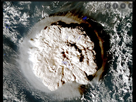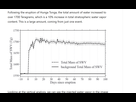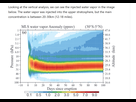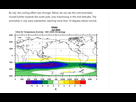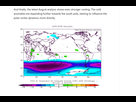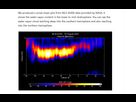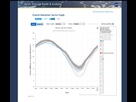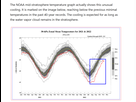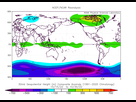[ALERTE ] REFROIDISSEMENT CLIMATIQUE A CAUSE D UN VOLCAN
- 1
Le 15 janvier 2022 une explosion super colossale et de nature systersienne s'est produite dans les Iles Tonga à 2000 km au nord est de la Nouvelle Zelande . Alors que les fanatiques ecologistes et la crasse climato rechauffiste nous expliquent que le réchauffement est un grand danger et utilisent un flux chaud venu des Açores sur l'Europe de l'ouest, c'est un refroidissement climatique qu'il faut craindre:
https://fr.wikipedia.org/wiki/%C3%89ruption_du_Hunga_Tonga_en_2022
L'explosion a été entendue jusqu'en Alaska à 9000 km et l'onde de choc a fait 3 fois le tour de la terre
Elle a envoyé du soufre dans l’atmosphère (mais ne quantité relativement faible) mais surtout des quantité d'eau et de vapeur d'eau immense comme l explique cette étude, ce qui refroidit grandement le climat dans l Hemisphere sud puis dans les prochains mois l'ensemble du globe :
Grande quantité de vapeur d'eau (10 % de la totalité de vapeur d'eau contenu dans l’atmosphère en quelques heures) a une altitude comprise entre 25 et 35 km qui refroidit la stratosphère de manière spectaculaire dans l'Hesmisphere sud qui connait des vagues de froids historiques depuis le mois de mai
Analyse de la vapeur d'eau
Le refroidissement ne cesse de s étendre et d'empirer :
Refroidissement de la stratosphere en mai
Juillet :
Aout :
Cette anomalie va durer plusieurs années et elle s étend petit a petit vers l Hemispher nord
Il faut donc s'attendre a un refroidissement climatique généralisé à partir de l'été prochain alors que la pegre réchauffiste est déchainée depuis l été chaud en Europe, alors que c est resté tres local.
Indépendamment de cela, le pole nord et le Groenland ont connu des anomalies froides tout l été et la banquise arctique est a son plus haut niveau depuis 2005 pour un mois de septembre, bien au dessus de 2012 (1 million de km 2 de +) et 2007 quand Al Gore nous annonçait sa disparition pour la fin de l’été 2020
Records de froids dans l hemisphere sud
https://www.lematin.ch/story/frappe-par-une-vague-de-froid-le-bresil-grelotte-998960173023
Au contaire, ce volcan a plutôt réchauffé le climat à cause de la vapeur d'eau agissant comme un gaz à effet de sere
https://www.lindependant.fr/2022/10/28/meteo-une-eruption-volcanique-responsable-des-chaleurs-exceptionnellement-elevees-de-cette-annee-2022-10767105.php

Le refroidissement climatique continue de s accelerer dans la stratosphere de l hemisphere sud avec des records de froid au niveau de la stratophere (25 km d'altitude)
Ce refroidissement de la stratophere provoque un rechauffement en altitude des hautes latitude de l hemisphere nord et va provoquer un hiver glacial en Europe et en Amerique (en gros des blocages du flux d'ouest doux et humide avec plutot des flux venant de l'Arctique ou de Siberie)
SEASONAL WINTER WEATHER INFLUENCE
Now, we all want to know how this will impact the global weather, especially (if at all) in the upcoming Winter 2022/2023.
For this purpose, we have produced a simple July-September temperature index covering the stratosphere over the southern hemisphere’s mid-latitudes. You can see it below, with several warm and cold seasons.
stratospheric-polar-vortex-cooling-anomaly-weather-winter-influence-index-noaa
What we did next is compare this changing index year-to-year with changing temperature and pressure patterns during the winter season in the northern hemisphere. This is called a linear correlation and compares the two parameters, revealing any potential connection.
There is one very important thing to add here. A correlation does not mean direct cause and effect, as another background signal can cause the same pressure anomaly pattern. More research is needed to confirm the stratospheric cooling weather response.
But we can still look at the basic data, trying to find a simple connection between the stratospheric cooling and the winter weather.
We can see that in the image below, where an indicated response to the south stratospheric cooling would be a negative NAO pressure pattern. NAO stands for North Atlantic Oscillation and describes the pressure pattern affecting North America and Europe.
stratospheric-polar-vortex-cooling-anomaly-weather-winter-influence-pressure-pattern-united-states
A negative NAO pattern means higher pressure over the north Atlantic and Greenland and lower pressure to the south. The image below shows the temperature pattern of an average negative NAO winter season. You can see colder temperatures over the northern and eastern half of the United States and Europe.
stratospheric-polar-vortex-cooling-anomaly-weather-winter-influence-historical-temperature-nao-pattern
If we look at the winter seasons following anomalously cold south stratospheric years, we can see a great example of a negative NAO pattern. High pressure over Greenland and lower pressure over the mid-North Atlantic.
stratospheric-polar-vortex-cooling-anomaly-weather-winter-influence-historical-pattern-data
Of course, we have to add that this does not mean the stratospheric cooling was responsible for these patterns. Each year has other much more direct influences. But there is a hint or a statistical pattern between the south stratosphere and the northern Winter season.
WINTER SEASON STRATOSPHERE
One area of linkage could be the stratosphere itself. If we look at the same years again, we can see that the corresponding pressure pattern in the Northern Stratosphere shows a weaker polar vortex circulation. That is shown by a higher-than-normal pressure and weaker winds.
stratospheric-polar-vortex-cooling-anomaly-weather-winter-influence-pressure-map-north-hemisphere
Also, looking at the northern stratospheric winter temperatures, we see warm temperature anomalies in the stratosphere in these winter seasons. This indicates a weaker stratospheric circulation, which can also mean a more disrupted jet stream pattern below.
stratospheric-polar-vortex-cooling-anomaly-weather-winter-influence-temperature-north-hemisphere
A strong Polar Vortex usually means strong polar circulation. This usually locks the colder air into the Polar regions, creating milder conditions for most of the United States and Europe.
In contrast, a weak Polar Vortex can create a weak jet stream pattern. As a result, it has a harder time containing the cold air, which can now escape from the polar regions into the United States and Europe. Image by NOAA.
polar-vortex-winter-influence-pressure-pattern-jet-stream-cold-air-snowfall
The weak polar vortex events typically result from stratospheric warming events. These events can collapse the stratospheric polar circulation, heavily modifying the weather patterns below and creating a negative NAO pattern.
We get an interesting picture if we combine all Stratospheric Warming events and look at the weather 0-30 days following the stratospheric warming events.
Below is the average pressure anomaly after a stratospheric warming event. It corresponds to a negative NAO pattern. This heavily disrupted circulation pattern supports a free path for colder polar air to move out of the polar regions.
polar-vortex-major-winter-stratospheric-warming-pressure-anomaly-forecast-2022-2023
The corresponding average temperature 0-30 days after an SSW event shows that most of the United States is trending colder than normal, and Europe is as well. But note that this is an average picture of many SSW events. Each individual stratospheric warming event is different and does not automatically mean a strong winter pattern.
post-stratosphere-warming-weather-temperature-impact-united-states-europe-winter-snowfall
Bordel et si c'était vrai.
Les températures sont anormalement basses et l'air trop fraiche pour un mois de Décembre, ce qui nous rappel les températures des années début 2000 avant l'arrivée du fameux "réchauffement climatique".
Le 08 décembre 2022 à 17:23:43 :
Bordel et si c'était vrai.Les températures sont anormalement basses et l'air trop fraiche pour un mois de Décembre, ce qui nous rappel les températures des années début 2000 avant l'arrivée du fameux "réchauffement climatique".
Trop basses pour décembre ? Il fait froid chez toi ?
Le 08 décembre 2022 à 17:23:43 :
Bordel et si c'était vrai.Les températures sont anormalement basses et l'air trop fraiche pour un mois de Décembre, ce qui nous rappel les températures des années début 2000 avant l'arrivée du fameux "réchauffement climatique".
?
https://meteofrance.com/magazine/meteo-questions/nos-hivers-seront-ils-de-moins-en-moins-froids
Perso j’ai eu un mois d’octobre hallucinant de bonne température ( comme tout le monde je crois ) avec des journées à 20 degrés.
Un mois de novembre qui a commencé à bien se rafraîchir sur la fin.
Et là début décembre des températures négatives le matin et la nuit ( avec du coup 2-3 semaines d’avance )
Donc y a moyen qu’on est un hivers froid si ça continue sur cette lancée oui.
- 1
Données du topic
- Auteur
- tigerlake21
- Date de création
- 29 octobre 2022 à 07:39:33
- Nb. messages archivés
- 13
- Nb. messages JVC
- 13
